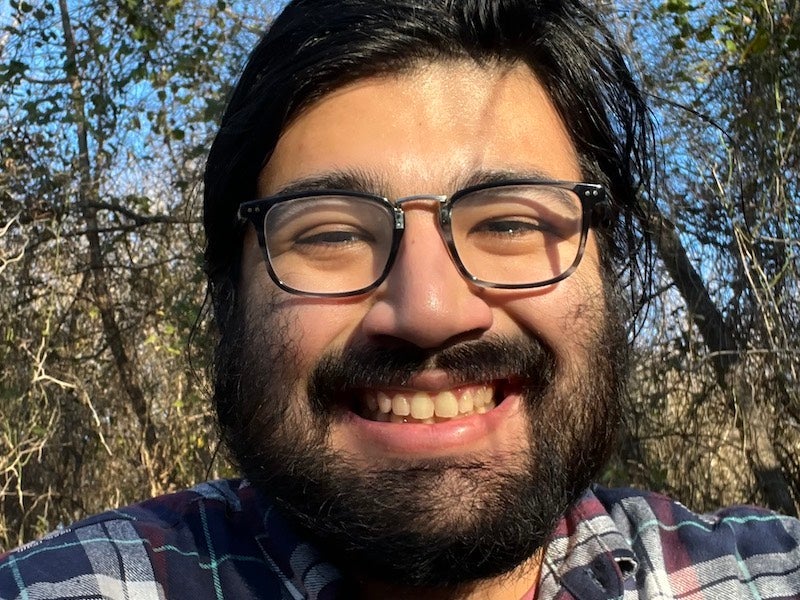A Beautiful Mess
Omar Hurtado stepped away from math and quickly learned why he missed it.
January 30, 2024
Kate Becker

Omar Hurtado
Photo credit: courtesy of Omar Hurtado
Some people say that math is like art: that it is a source of beauty, elegance, and connection to the deepest truth. Omar Hurtado ’16 doesn’t buy it.
“I think you’re basically solving weird little puzzles.” Don’t take that as a put-down. Hurtado likes weird little puzzles. In fact, he wouldn’t want to do anything else—and he has tried.
As a student at Oberlin, Hurtado puzzled his way through his math classes. “They would give me a puzzle, I’d play with it, mess around with it, until I figured out how to do it,” he recalls. “Especially when problems have a bit of a physical context, I can really picture them.”
Hurtado graduated from Oberlin with high honors in mathematics. A math career was always on his mind, but he knew that the path through academia could be long and bumpy. So after graduation, he tried out an office job. He answered phones. He filled out spreadsheets. He had no fun at all. The conclusion was obvious: “I would rather be doing math!”
When you take math in undergrad, you’re looking at very well-established theories. Usually they’re all at least 100, 150 years old. Now, at the cutting edge, it’s very far removed from that. The progress is incremental. You’re chipping away at the edge of what we know.”
Today, Hurtado is a PhD student in math at the University of California, Irvine, where he works on problems in mathematical physics, a field he was first introduced to by his Oberlin thesis advisor, Associate Professor of Mathematics Chris Marx.
“Physicists usually use theoretical models and then calculations or numerical simulations to predict the outcomes of experiments,” says Marx. “But there are limits to what you can do based on numerical simulation or computation. The advantage mathematics has is that it is able to lift the problem to a more abstract situation.
Hurtado is working on a problem you might call “electrons behaving badly.” If you could magically travel inside a copper wire, you would see the copper atoms linked up neatly in a Tinker Toy-style lattice. An electron can breeze right through. That is what makes copper such a good conductor. But in some other materials, like many metal alloys, the Tinker Toys are a disordered jumble, an arrangement “so haphazard it might as well be random,” Hurtado says. Electrons trying to muscle their way through these scrambled-up atomic landscapes often get stuck, meaning that the alloy cannot conduct electricity.
The wrinkle is that sometimes electrons get stuck in a wire or a sheet of foil, even when the atomic lattice is relatively tidy. Hurtado wants to figure out why.
Physicists have their own answers, often gleaned by observing how light waves travel through special fibers. But when mathematicians take on problems in physics, they do it differently. “We as mathematicians generally agree with [physicists],” says Hurtado. “But we don’t settle for, ‘Oh yeah, it’s probably true.’ We settle for, ‘Okay, we know it’s true.’” Which puts Hurtado in the unusual position of studying materials without actually testing or touching them, instead representing them on paper using matrices and vectors.
Hurtado presented his work at the Great Lakes Mathematical Physics Meeting (GLaMP), held on campus at Oberlin in June. The first time he attended GLaMP, back in 2019, it was an eye-opener. “It was a you-don’t-actually-know-anything event,” he says. Instead of the highly-polished results he was accustomed to from his classes, the results were quirky, raw, and unfinished.
“When you take math in undergrad, you’re looking at very well-established theories. Usually they’re all at least 100, 150 years old,” says Hurtado. “Now, at the cutting edge, it’s very far removed from that. The progress is incremental. You’re chipping away at the edge of what we know.”
It might not be elegant. It might actually be pretty messy. But to Hurtado, that’s what makes it so much fun.
Kate Becker is a freelance writer based in Massachusetts. She earned a degree in physics from Oberlin in 2001.
You may also like…
Oberlin Provides Foundation for Future Education
Sherry Miao ’23, who majored in economics, is currently pursuing her master’s in public policy at the Harvard Kennedy School (of Harvard University).
Knocking It Out Of The Park
From studying economics to MLB coaching, Max Anastasio is paving his way with perseverance.
Five Oberlin Alumni Earn 2025 Guggenheim Fellowships
Five Oberlin alumni have been awarded prestigious Guggenheim Fellowships.


